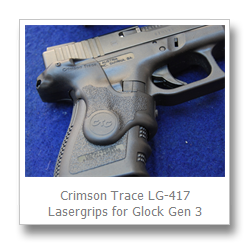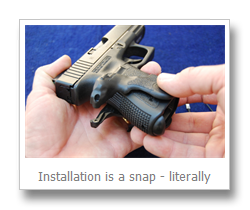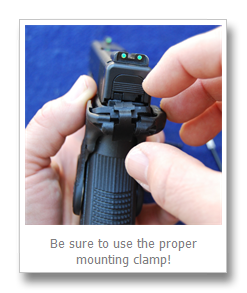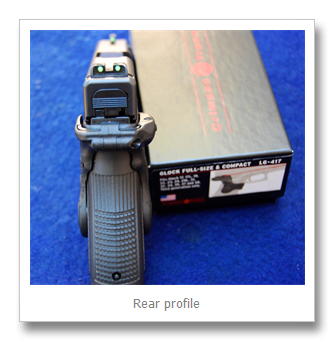Beam me Scotty…
| Suggested Retail Price: $339.00 | www.crimsontrace.com |
| The Good |
| Love, love, love that the newer model Lasergrips for Glocks have a positive on/off switch for the laser. |
| The Bad |
| Given the solid molded grip design of the Gen 3 Glocks, it will add a bit of circumference to your grip. |
| The Ugly |
| There are still “gun dude” know-it-alls out there who believe that lasers are a gimmick bound to get you ‘kilt’ in a real gunfight. You have to explain to them that you also know how to use sights. |
| Our Rating |
 Four Nuns! No problems with any of our holsters, no accidental activation, and rock solid mount. A nice piece of equipment. Four Nuns! No problems with any of our holsters, no accidental activation, and rock solid mount. A nice piece of equipment. |
First Impressions
The thing we like best about the Crimson Trace Lasergrip design is the instinctive activation. Grab your gun, and the laser is pointing at stuff you’re going to shoot. No levers, switches or internal parts replacements – just an instant and somewhat sexy improvement. It’s kind of like a Botox treatment for your gun, although you don’t have to replace it every six weeks.
Installation
Putting these on was a snap. We didn’t even need the instructions. Well, not at the beginning anyway. The steps are pretty simple.
- Unload your gun
- Now unload it again, and check the chamber this time to make sure its empty
- Slide your snazzy new Crimson Trace LG-417 lasergrip over the bottom of the frame
- Make sure the bright red shiny light part is facing forward
- Choose the proper mounting clamp for your particular Glock (see below)
- Screw it down tight using the enclosed tool
- Go look exceedingly cool at the range
See? Pretty simple. No removal of pins, springs, or other itty-bitty parts from your gun.
Front activation button – Protects important things…
The LG-417 features a front activation button. This is a good thing for concealed carry guns. We’ve had lasers in the past with side activation buttons. Unfortunately, we’ve found that pressure from inside the waistband holsters can activate the laser, thereby sending a blazing hot beam of gamma mega-death laser power right at your, ummm, sensitive areas. Actually Crimson Trace assures us that their lasers are harmless in that respect, but it does tend to wear the batteries faster. And avoiding this problem altogether means that you don’t have to explain why your pants are glowing red. Yes, you could crack plenty of off-color jokes about being hot to trot or making a great addition to any city’s red light district, but we feel its better to avoid the situation entirely.
To zero or not to zero – That is the question…
The Crimson Trace Lasergrips come with adjustable windage and elevation settings that allow one to line up the laser ‘dot’ with a specific point of impact at a specific distance. The laser lens is of course not physically located in the center of the bore – generally bullets go there – and that might cause damage to your Lasergrips. So thinking back to Mrs. Finglebaum’s 9th grade Geometry class, if you set the ‘dot’ to match the point of impact at a given distance, the projectile line of flight and the laser beam converge to the specified point of aim, then continue to diverge again after that. Mrs. Finglebaum would call that an example of intersecting line segments that have different slope-intercept equations. Or would she refer to them as rays? Rays go on forever. A bullet stops traveling at some point so it’s more like a line segment. But then again it’s constantly falling, making it technically more like some type of parabolic curve. Does a Crimson Trace laser extend forever? Is it a line segment or a ray? Will it Rendezvous with Rama a few billion light years from my pistol range? Wow, geometry is hard…
Bottom line? You have two choices on ways to ‘zero’ your Crimson Trace Lasergrips:
- Be precise – at a distance. Pick a distance where you want the bullet impact and the laser dot to occupy the same physical space on your target. One of the primary advantages to this method is that it feels exceptionally cool to put the laser dot on some small target, like a jobless mosquito, and blow it away. Many people at your shooting range can be impressed by this. The disadvantage is that for both longer and shorter ranges than your zero setting, the bullet will not impact exactly on the dot. It will be close, but not exact, depending on how far your actual shooting distance is from your zero distance. Dig up Mrs. Finglebaum’s book and you’ll see what we mean.
- Get parallel. By our unofficial measurements on a Glock 32 Gen 3 with the LG-417 mounted, the laser beam lens is just about 1/2” below the center of the bore and about 3/4” to the right of the bore. So, if you take a whack at adjusting the laser to remain parallel to the bore, then distance becomes a non-issue. Your bullet will hit a smidgen high and a couple hair lengths to the left of where the shiny red dot is. Then you can have some extra fun at twilight trying to whack targets at 100 yards or so.
Two good options and all personal preference. Crimson Trace sets a reasonably good zero for 50 feet. So take your choice. Tinker or not.
Read those instructions!
Apparently the Gen 3 full size and compact Glocks can have some slightly different frame configurations on the beavertail right below the slide. The LG-417 laser grip kit comes with two different sized mounting clamps to account for your particular version. It’s important to identify your variant per the diagrams in the Installation Handbook because as we, umm, found out the hard way, you can get a less than secure mount using the wrong clamp. We initially used the larger clamp and installation seemed to work fine, but we quickly noticed that the laser grip would not hold a zero after holstering and un-holstering. A quick look at the instructions led us to swap out the larger clamp for the smaller, and voila, problem solved. That myth about guys not needing to read instructions? Still not true.
Positively engaging!
The newer LG-417 series features a positive on/off switch mechanism – a great improvement over the earlier Glock models. We like to do other daytime stuff that’s not so laser friendly like Steel Challenge, IDPA, and general range plinking on nice sunny days. It’s nice to be able to disengage the laser without dismounting it. This model has a deeply recessed pressure switch on the left grip panel, just above the battery compartment. A small pinky can be used to turn the laser off entirely. If you have fat fingers like we do, just use a bullet to get to that recessed switch. That method looks mucho more macho anyway.
Closing arguments
One of the most interesting findings about the LG-417 laser grips is the relatively minor impact of practical grip circumference. This sounds dirty already, but we’re going to plow ahead and hope for the best… The grip itself technically covers 3 of the 4 sides of the Glock grip, but the only finger that is fully impacted is the road rage (middle) one. For us, the ring and pinkie fingers did not come in contact with the laser grip on either the front or left side of the Glock frame – they naturally positioned just beneath. So, while the laser grips appear to add noticeable width, in actuality, only the right side impacts shooting hold.
One more thing. Just hypothetically speaking, if we had forgotten to renew our concealed carry license, and had to re-take the entire state mandated training class, we might have done that while testing the Crimson Trace Lasergrips. And while shooting the living crap (hypothetically speaking) out of the center of the huge target during the qualification stage (it is only 3-5 yards after all) the state certified instructor expert might have smugly inquired “Well hot shot what are you going to do if those laser sights don’t work?” Again, hypothetically speaking, we might have answered, somewhat sarcastically, “well that’s what the TruGlo TFO sights are for numbnuts.” Hypothetically speaking of course.
We like it. Especially because the old shooting fart thinks we don’t know what we’re talking about.
Check out other My Gun Culture product reviews here!











[…] our review of the Crimson Trace LG-417 Lasergrips we found these to be a 4 Nun […]
What holsters did you test it with, with “no problems”?
Boy this has been a while, but I know I’ve carried this setup with CrossBreed Supertuck, Fobus, Uncle Mike’s kydex, a couple of DeSantis models, a Mitch Rosen and some others. Have you had trouble with a specific holster? Basically, the entire mechanism is out of the way of most holsters.